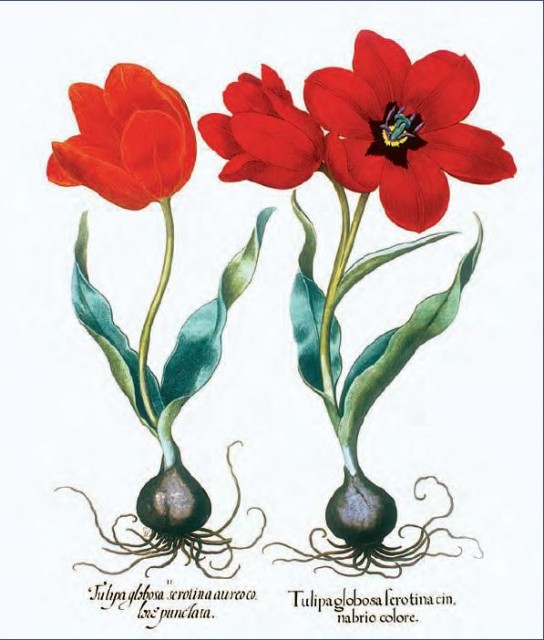Carolus Clusius, the Leiden Botanical Garden, and the Tulip
Within a few decades, botanical gardens were opening elsewhere in Europe. The University of Leipzig, Germany, began work on its garden even earlier, in about 1542, but it opened later than the Italian ones. In about 1567 the University of Bologna converted its physic garden into a botanical garden. University administrators were recognizing that a botanical garden was a necessity if they were to provide their students with a truly comprehensive, up-to-date education, and universities were competing for students.
The first Dutch garden opened in Leiden. The University of Leiden was founded by William of Orange (1533–84) in 1575. It was the first university in the Netherlands and its curators were determined that it would offer the very latest in educational facilities. In 1587 the curators asked the burgomasters of Leiden for permission to create a botanical garden for the benefit of medical students on a site beside the former convent building that housed the university. The university called it a hortus academicus (academic garden). It took the burgomasters until 1590 to make up their minds, but they finally agreed. The garden was duly prepared and planted, and a professor of medicine, Geraerdt de Bont (1536–99), also known as Bontius, was given a pay rise to teach herbalism and medical botany in summer, while continuing to teach anatomy in winter. This arrangement proved unsatisfactory, however, and the university authorities began to look elsewhere, eventually appointing the Flemish botanist Carolus Clusius (1526–1609), giving him the title of honorary professor of botany.

Clusius arrived in Leiden in 1593, but he was 67 years old and earlier that year he had injured his hip so he was unable to undertake physical work in the garden. He had still not recovered by the spring of 1594, and he asked the university to appoint someone to help. Consequently, it was a Delft apothecary Dirck Outgaertsz Cluyt (1546–98) who planted the garden during the summer of 1594. Cluyt had a large and well-established apothecary business with a large physic garden, which he managed personally, to support it, and he had started to work on the Leiden garden in 1591. The university could not appoint him curator, however, because he had no formal botanical qualification. The duties of the curator of the botanical garden included teaching and Cluyt and his son Outgaert gave outdoor lessons in summer and indoor tuition in winter. Even after he had recovered Clusius took little part in the running of the garden, spending his time in his own garden where he grew bulbs, and especially tulips.
Carolus Clusius is the Latin name of Charles de l'Ecluse or l'Escluse, who was one of the most influential botanists of the 16th century. He was born in Arras, now in northeastern France but then in Flanders, on February 19, 1526, the son of Michel de l'Escluse, who was a councillor at the Artois provincial court. He studied law at the University of Louvain and briefly at Marburg, but in 1551 he was studying medicine and botany at the University of Montpellier, where he qualified as a physician. However, he was more interested in botany and never practiced medicine. During his student years, Clusius became proficient in eight languages, and his first book was a French translation of Rembert Dodoens's Cruydeboeck.
Clusius held a number of posts in different parts of Europe before in 1573 being appointed court physician and superintendent of the imperial garden of the Holy Roman Emperor Maximilian II (1527–76), in Vienna. This position allowed him to travel widely, studying and collecting plants. After moving to Leiden, Clusius remained there until his death on April 4, 1609.
Tulips (Tulipa species) grow naturally around the Mediterranean and from Turkey eastward to China. The ancestor of the modern cultivated tulip originated in Turkey and was introduced to Europe in the middle of the 16th century. Tulips grow from bulbs, and Ogier Ghislain de Busbecq (1520 or 1521–92) sent Clusius some bulbs from Turkey, and Clusius took them with him to Leiden. Busbecq was a herbalist and also the ambassador to the Ottoman Empire of the Holy Roman Emperor Ferdinand I (1503–64). The following illustration shows the tulips that were being cultivated at about that time.
Clusius planted his bulbs, and the plants flourished. He observed them closely and discovered how to produce varieties with multicolored and feathered petals. These showy blooms made tulips so popular that the price of bulbs rose rapidly. This soon led to an extraordinary episode of price inflation known as tulipomania.
As well as introducing the tulip to northern Europe, Clusius popularized several other garden plants, especially alpine species, but also including the potato. He produced one of the first studies of the flora of Spain (1576) and of Austrian and Hungarian mountain plants (1583). These were published together as Rariorum plantarum historia (History of rare plants) in 1601. Clusius's book Exoticorum libri decem, quibus animalium, plantarum, aromatum, aliorumque peregrinorum fructuum historiae describuntur (Ten books of exotic life-forms, the history and uses of animals, plants, aromatics, and other natural products from distant lands), published in 1605, was a major botanical and zoological survey.
- Pisa, Padua, and Florence, the First Botanical Gardens
- The Rise of the Herbarium
- Luca Ghini and How to Press Flowers
- Lancelot “Capability” Brown
- Formal Gardens, Restoring Order to a Chaotic World
- Identifying Plants: The Herbal Becomes the Flora
- The Doctrine of Signatures
- The Apothecaries’ Garden at Chelsea
- Monastic Gardens